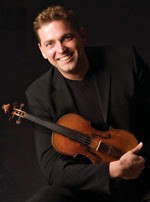Tucson Symphony Orchestra continues its program offering students any unsold seat for $10 one hour prior to most orchestral concerts.
The TSO Classic Concert #5: “The Red Violin” and Mahler’s “Fifth Symphony” will take place at Tucson Music Hall, Tucson Convention Center, Friday at 8 p.m. and Sunday at 2 p.m.
Is Mahler’s “Fifth Symphony” “the greatest symphony ever written”? Or is it, aside from its achingly gorgeous Adagietto, a sorely incomprehensible cacophony? Is John Corigliano’s “Concerto for Violin” a fitting and well-deserved summary and culmination of his award-winning score to the 1998 film “The Red Violin”? Or is it gussied-up movie music written to squeeze a little more from one of his most lucrative commercial successes? If you have a current student ID, you can show up anytime within one hour prior to one of the TSO’s two Classic Series performances this weekend, pay only $10 and decide for yourself. Often, these tickets are not simply for the less desirable seats, but include great promotional and patron-returned tickets — some of the best in the house.
Corigliano’s “Concerto for Violin” is a powerful violin showpiece, well-crafted from themes he composed for the award-winning score to “The Red Violin,” which traces the amazing “life” of a violin made in Cremona in 1681 through four centuries and five countries. While the concerto’s four movements — “Chaconne,” “Pianissimo Scherzo,” “Andante Flautando” and “Accelerando Finale” — do not follow the movie’s dramatic story line, they draw their intense depth and breadth from its haunting images, which traverse through Vienna of 1793, Oxford of the late 1890s and Shanghai of the late 1960s, ending in Montreal of 1997. The sequences of the red violin’s amazing journey follow a set of tarot cards selected by the maid of the violin maker’s dying wife: Long Life, The Hanged Man, The Devil, Justice and Death. Lasting 35 minutes, the concerto is a sparkling musical jewel, which former TSO Concertmaster Steven Moeckel is sure to make brightly sparkle.
Mahler’s gigantic “Fifth Symphony” is a particular favorite of celebrated Mahler interpreter George Hanson, TSO’s music director/conductor. It is a sprawling, horn-heavy, five-movement work lasting 70 minutes. It comprises a pivotal place in Mahler’s orchestral oeuvre, which Maestro Hanson describes as “one long, continuous narrative, expressing an unequaled range of human emotion.” This symphony’s staggeringly diverse emotional content is further exaggerated by the distinctly unsettling sequence in which they unfold. Its first movement is a long and dark funeral march, followed by an even more wildly veering second movement, presented as a persistent and violent storm. Having established this thick layer of serious drama and apparent trauma, the third movement, a Scherzo, suddenly brings sunny Viennese emotions out to dance and play, creating a most surprising — even disorienting — emotional transition. The final two movements only increase the listener’s sense of the unexpected. Movement four is Mahler’s deservedly famous “Adagietto”, an intensely personal and bittersweet creation that in itself often moves its listeners very deeply into self-reflection. Its poignant beauty as a musical statement is of such quality that it can easily stand alone as a composition, as it does in Luchino Visconti’s award-winning 1971 film, “Death in Venice.” Yet, within this gigantic symphony, this oh-so-tender, heart-rending music flows directly into a super-energized, exuberant and breath-taking “Rondo-Finale.” Somehow, at its conclusion, Mahler wrings great triumph out of this harrowing, extremely nonlinear and emotionally-charged epic journey. It truly is a “story without words” for the ages.
Experiencing great art can be one of the most valuable pieces of a liberal arts education. And for students, for $10, this looks to be a steal for great musical art to kick off the new semester.









